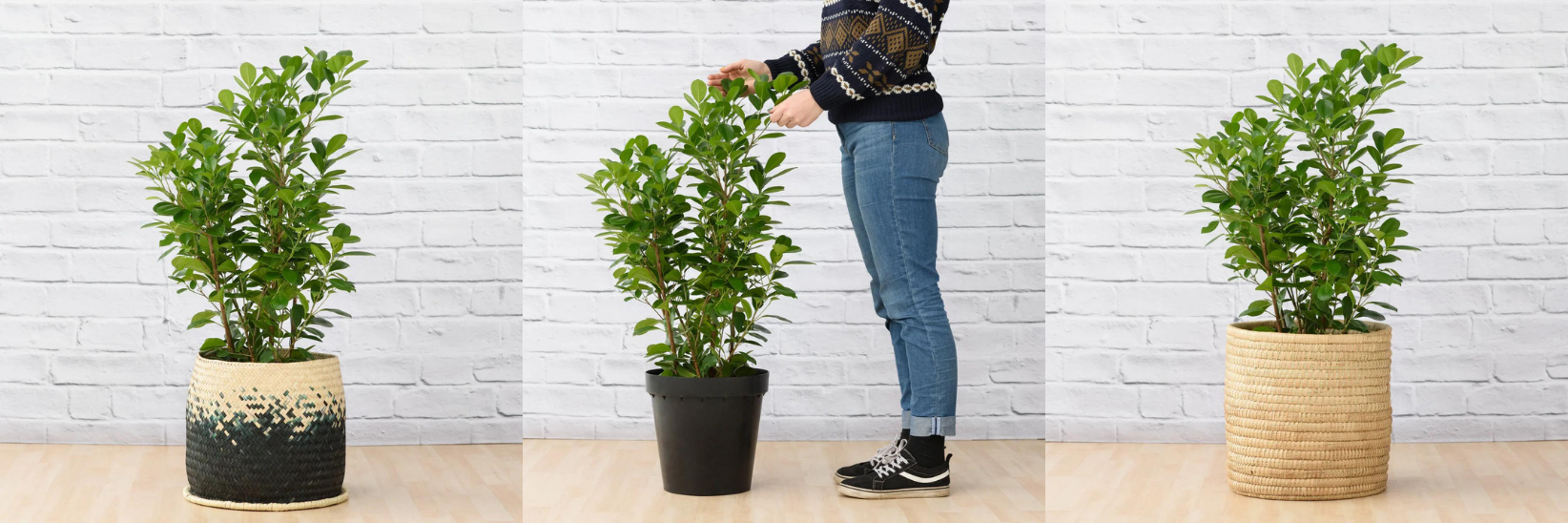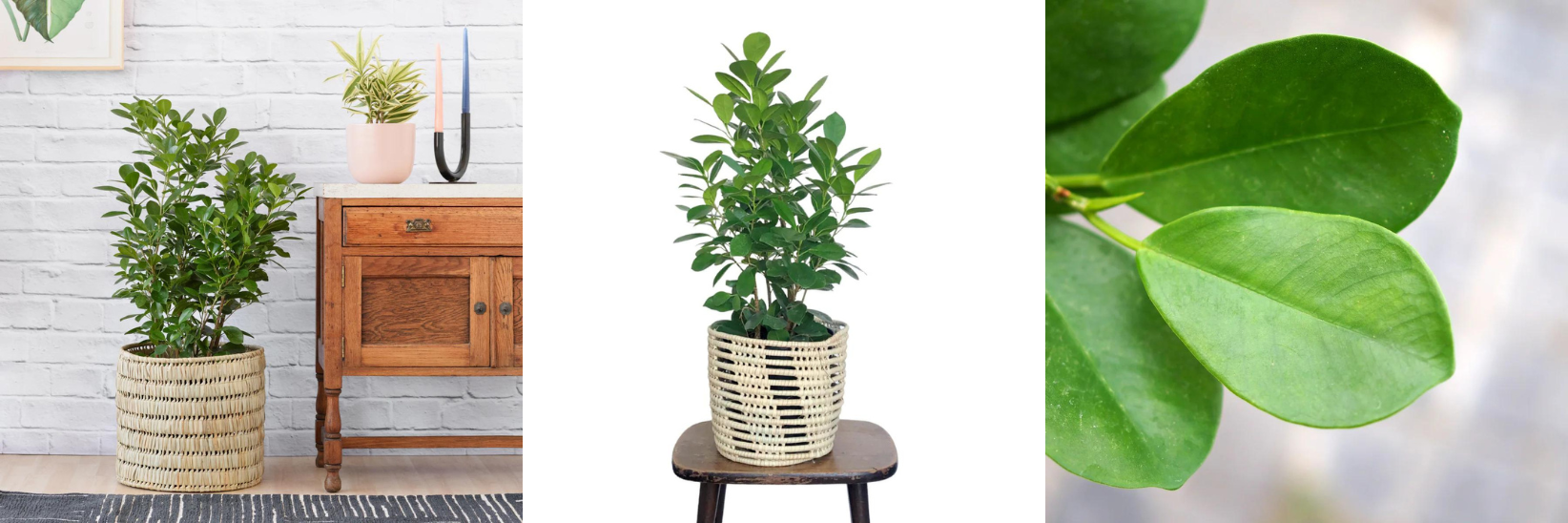Ficus Moclame Care Instructions
Scientific Name: Ficus Microcarpa
Synonyms: Ficus Moclame, Chinese Banyan, Malayan Banyan, Indian laurel, Curtain fig, or Gajumaru, Pot Belly Fig, Laurel Fig, Laurel Rubber and Strangling Fig.
The Ficus Moclame, is an understated newcomer to the houseplant scene that is swiftly making its mark with gusto. These delightful specimens, a family member of the Fiddle Leaf Fig but with a more accommodating demeanor akin to the Ficus Benjamina, offer a splendid choice for newbie plant parents seeking an effortless yet striking addition to their homes.
Their charming glossy emerald green foliage forms a lush canopy, perfect for sculpting into a refined lollipop silhouette. Native to India, Ficus Moclame exhibits a commendable resilience to occasional dry spells while favouring a consistently moist environment and basking in bright, indirect sunlight, though it graciously accepts gentle morning or late afternoon rays.

As moderately fast growers, these indoor wonders maintain a dignified stature, ensuring they remain a refined long-term fixture within any home or office setting. Whether nestled in a contemporary palm leaf basket for a touch of sophistication or showcased in a bold, eye-catching planter, the Ficus Moclame promises to captivate as a floor standing masterpiece.
Not only do these majestic specimens bring that much needed green indoors, but they also function as proficient air purifiers, imbuing your living space with fresh, invigorating air. Truly, the Ficus Moclame is a botanical marvel that combines beauty, resilience, and utility, offering an unparalleled addition to any indoor sanctuary.
Toxicity: All ficus are considered toxic, especially the latex that extrudes when cut.
Ficus Moclame Common Symptoms
- Yellowing leaves: There are a few causes of yellowing leaves in your ficus, namely overwatering, nutrient deficiencies, and excessive direct sunlight. Evaluate your care regime and adjust accordingly. Be sure to allow the Ficus to just reach dryness before watering, and to ensure the pot is draining well and the soil is not soggy. Feed your plant on a regular basis, and keep it out of direct sunlight.
-
Browning Leaves: Consistent care is key to preventing common issues with your Ficus Moclame. Browned and crisped leaves can often signal underwatering, inconsistent watering, or low humidity. Ensure you regularly check the soil moisture and adjust watering accordingly, aiming to keep the soil lightly moist.
If you observe browning and crispy edges on the leaves, it's crucial to assess the humidity levels. Consider relocating the plant to an environment with higher humidity, or place it on a pebble tray filled with water to increase moisture in the air around the plant.
Furthermore, be vigilant for any cold drafts that may be affecting your Ficus Moclame. If you detect drafts, it's advisable to move the plant to a spot with more stable temperatures to prevent stress. By staying attentive to these factors and providing optimal conditions, you can help your Ficus Moclame thrive and maintain its vibrant foliage. - Leaf Drop: can be caused by stress from environmental changes, such as moving the plant to a new location or sudden fluctuations in temperature or light. It is best to minimise changes in the plant's environment, gradually acclimatise it to new conditions, and ensure consistent care to reduce stress. For more details on how to prevent leaf loss, please see below.
- Slow Growth or No Growth: This is usually caused by a few factors, and sometimes in tandem with each other. Slow growth can be caused by insufficient light, lack of fertiliser as well as the plant being rootbound, meaning it has reached the maximum size it can sustain itself in the amount of soil and space it has available. For best results assess the different factors that can cause slow growth and adjust accordingly by: Placing the plant in a location with bright, indirect light, fertilise it regularly with a balanced fertiliser formulated for indoor plants during the growing season, and consider repotting if roots are overcrowded.
- Pests: Most houseplants are resilient to pests if kept in their optimal conditions. Ficus Moclame can be susceptible to Spider mites, mealybugs, scale insects, which are all common houseplant pests. Inspect the plant regularly for signs of pests, such as leaf drop and yellowing, webbing, sticky residue, or visible insects. Treat infested areas with a quality pesticide such as Pyrol or Neusodan, and isolate the plant to prevent pests from spreading to other plants. Regularly wipe down leaves with a damp cloth to remove dust and discourage pest infestations. To identify pests, have a look at our: Pest Identification Blog.
How To Deal with Leaf Loss in Ficuses
- Ensure Consistent Watering: Ficus plants are sensitive to both overwatering and underwatering. Keep the soil evenly moist but avoid waterlogging. Check the soil regularly, and water only when the 6 cm to 10 cm feels dry; this could be between 7 and 10 days, though I would check in around every 10 days for best results. If it is a big plant with a lot of soil, this can take longer to dry out. Consistent moisture helps prevent stress and leaf drop. Also make sure that there is no water sitting in the tray after 15 minutes after being watered. Consistency is key!
- Maintain Stable Temperatures Ficus plants dislike sudden changes in temperature. Avoid placing your plant near cold drafts, heating vents, or air conditioning units. Keep the temperature steady, ideally between 15-24°C, to reduce shock. If you have a tiled living space, this can be tricky with fluctuations in temperature due to the weather. In time, as the weather stabilises, things should improve.
- Gradually Adjust Light Exposure: Ficus plants thrive in bright, indirect light. Sudden changes in lighting, such as moving from low light to direct sun, can shock the plant and cause leaf drop. Gradually introduce your Ficus to brighter light over a few days to help it acclimate. Find a position where the plant can get some direct but soft morning sunlight for a maximum of 3 hours - the soft sun will help boost photosynthesis and help with faster recovery. Make sure to place it at least 30cm away from a window where the light is shining through, as the window can act like a magnifying glass.
- Increase Humidity: Low humidity can stress Ficus plants, especially in dry indoor environments. Boost humidity by misting the leaves regularly, placing a pebble tray under the plant (this is a tray filled with pebbles and a little water), or using a humidifier to maintain a comfortable environment. Humidity is key here!
- Avoid Frequent Relocation: Ficus plants are sensitive to being moved, which can result in shock and leaf drop. Once your Ficus is in a suitable location, avoid relocating it unless absolutely necessary. If moving is required, do so gradually to let the plant adjust. Hence, please only move it to where it can get better light.
- Feed Lightly with a Seaweed fertiliser: Fertilise your Ficus sparingly during the growing season (spring and summer) using a seaweed-based fertiliser like Kelpak, which is high in added growth hormones and assists plants with stress recovery. If the plant has dropped many leaves, prune lightly to encourage new growth and help the plant focus energy on recovery.
Ficus Moclame Care Instructions
- Origin: South East Asia, mainly India.
- Height: Can grow to between 1.8m - 3m indoors.
- Light: Bright, filtered light is best. Avoid harsh, direct sunlight. Will tolerate gentle, direct morning sunlight.
- Water: Keep soil very evenly moist, and avoid overly dry or overly soggy potting soil.
- Humidity: preferably 50% or higher. To raise the humidity for your plant. Spritz it daily, and place a plant on a pebble tray. Will also tolerate average room humidity if care is taken with watering.
- Temperature: Ficus prefers warm environments between 17 °C and 27°C.
- Soil: A very well-draining organic medium that will hold onto some water.
- Fertiliser: Fertilise every two weeks from spring to autumn with a balanced liquid fertiliser.
- Pruning: Pruning the Ficus Moclame is best done in the spring or early summer to encourage new growth. Trim back any leggy or overgrown branches to maintain their shape and promote a bushier appearance. Regular pruning also helps remove dead or diseased foliage, improving the overall health and aesthetics of the plant. Please note that pruning should only be performed on healthy plants with vigorous growth. NOTE: White latex will exude from the cuts, and this may cause skin irritation, It is best to wear gloves when pruning.
- Repotting: For optimal growth, consider repotting your Ficus Moclame in the springtime. Select a pot that's just a tad larger than its current one, about 3-5cm bigger, to prevent overpotting and encourage robust root growth. Make sure the new pot has ample drainage holes to prevent waterlogging, ensuring proper moisture levels for your plant.Ideally, aim to repot your Ficus every 1-2 years to refresh the soil and provide adequate space for its roots to expand. When repotting, handle the roots gently to minimise stress on the plant. By following these repotting guidelines, you'll help your Ficus Moclame thrive and flourish in its new home.
-
Propagation: Embarking on the propagation journey is an exciting endeavour, best pursued during spring or early summer months when the plant is in full growth mode. A straightforward method involves taking stem cuttings from robust, mature branches. Aim for a cutting length of approximately 8–14 cm, ensuring there are at least a couple of leaf nodes present. Utilise sanitised, sharp scissors or a knife to make a clean cut directly below a node.
After removing any lower leaves, dip the cut end into a semi hardwood rooting hormone to enhance success. Plant the cutting into lightly moist potting soil with Perlite for optimal drainage, ensuring only the leaf portion protrudes above the soil surface. Provide bright, indirect light while maintaining consistent soil moisture, avoiding exposure to direct sunlight or chilly drafts.
Enclose the pot and put it in a clear bag or miniature greenhouse, and introduce bottom heat using a heating pad to maintain temperatures above 18°C. Once the cutting sprouts a second leaf, transition it into its own pot, spacious enough to accommodate growth. Adhere to the same care regimen as the parent plant, exercising patience and diligence for successful propagation, typically spanning around five months.
If in stock, shop for Ficus Moclame here.




